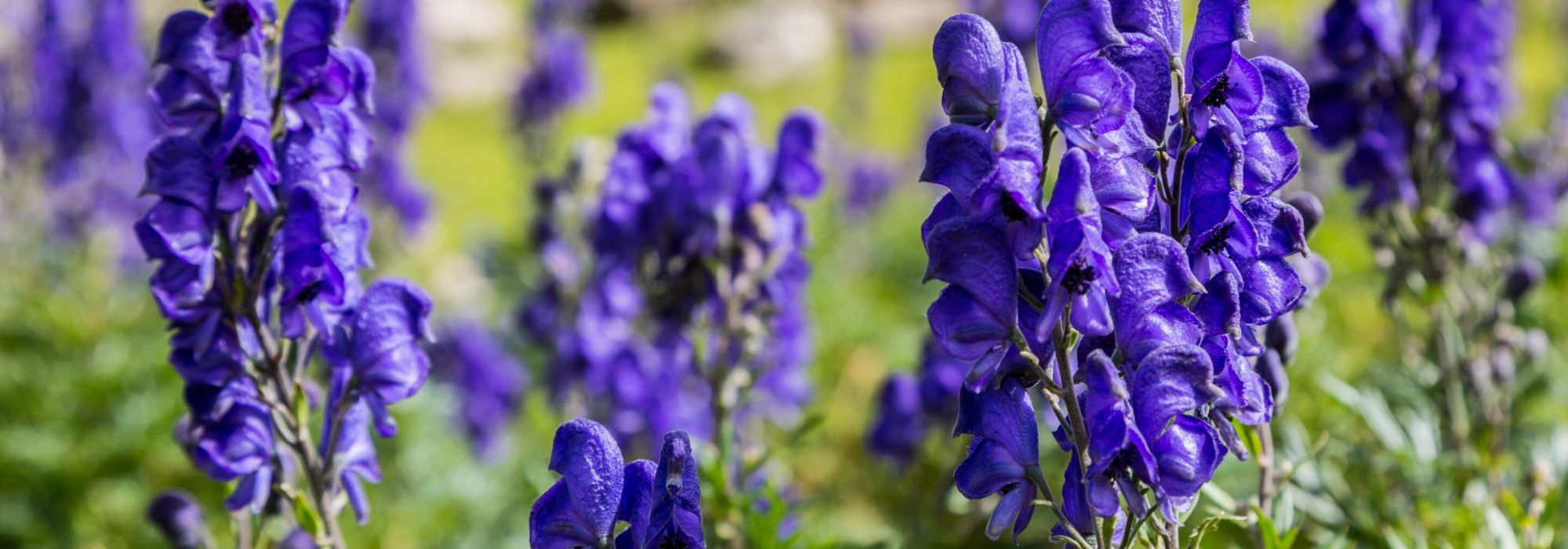
7 toxic plants to know before planting them in the garden
7 toxic plants to know before planting in your garden
Contents
Hidden behind beautiful colourful flowers, some plants are nonetheless toxic! More or less dangerous for humans and animals, they should be treated with caution and handled carefully. Here are 7 toxic plants to know before planting them in your garden.
Aconite
Aconite, one of the most toxic plants of our flora because it contains aconitine. Since antiquity, it was applied to the tips of hunting tools, and to drinking water, to poison it. Everything in aconite is toxic, especially roots! That nicknamed “vegetable arsenic” can cause death from 3 g of ingestion and severe poisoning by contact. So always wear gloves when handling it!
However, it offers magnificent shades of blue in your borders. Sometimes pale blue with Aconitum ‘Stainless Steel’, deep blue with the cultivar ‘Spark s Variety’ or indigo blue for Aconitum napellus. Some varieties, such as Aconitum cammarum ‘Bicolor’ offer a subtle blend of violet-blue and white. These colours adorn a flowering of large flower spikes comprising multiple small flowers in the shape of galeas. This hardy perennial flowers between May and October and grows between 60 cm and 1.50 m tall. It prefers partly shaded positions, fresh, humus-bearing soil. Aconites find their place within a border, accompanied by asters, fennel and Selinum wallichianum. They should be avoided where young children are present, but will not pose problems for informed adults.
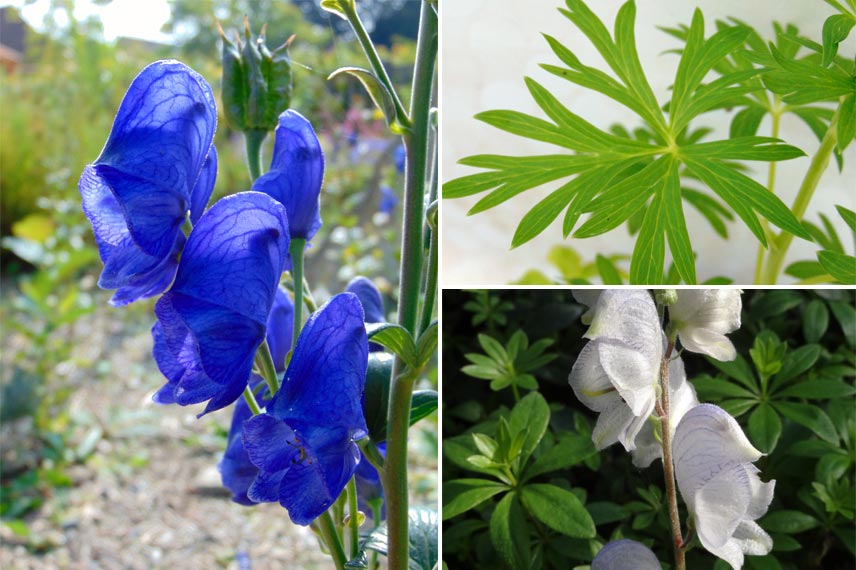
Aconitum napellus (flowering blue), detail of the leaf and Aconitum Stainless Steel (light-coloured flower).
Daphne
Also called Wood-Joli, Daphne is a bush known for the intoxicating scent of its flowers. It is entirely toxic, especially berries and bark. Ingestion causes irritation of mouth, tongue and throat, as well as gastrointestinal disorders. If exposure is by contact only, skin inflammation will occur, causing redness, swelling and blistering.
Despite its toxicity, don’t miss out on this bush with many attractions! Whether white or pink, its star-shaped flowers are very fragrant. Placed close to house, Daphne fills terrace with fragrance. Some varieties flower as early as February, like the Daphne odora ‘Aureomarginata’, while others wait until late spring such as the Daphne burkwoodii ‘Somerset’. The cultivar Daphne x transatlantica ‘Eternal Fragrance’ offers two flowerings: May to July, then September to October. This bush is ideal for a small garden or a terrace thanks to its small size and compact habit. It is fairly easy to grow, preferring light, acidic soil. However, it dislikes stagnant moisture. Plant in free-draining soil or in a pot. Not liking scorching sun, place in shaded or semi‑shaded position. Fairly hardy, daphnes tolerate down to -15°C depending on variety. A little protection such as mulching and a winter fleece won’t go amiss for this handsome bush!
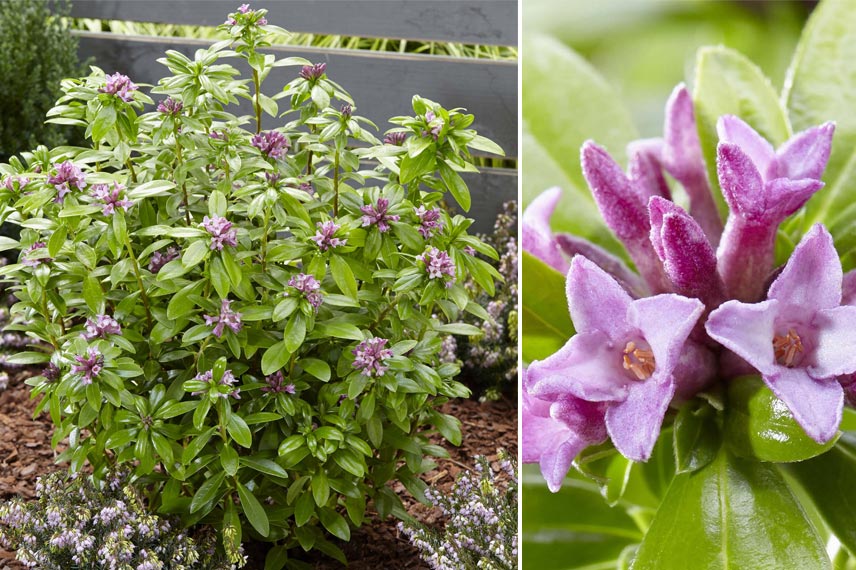
Daphne odora Sweet Amethyst
Meadow saffron
“Colchicums in the meadows are blooming, are blooming”… Although this wildflower is celebrated in song, it remains poisonous! It contains colchicine, the lethal dose for a human being is 20 g. Small ingestion can cause digestive problems, while a larger amount may lead to cardiac failure. This perennial is also called “dog-killer” or “poisonous saffron”. Indeed, their flowers look similar, yet one is edible and the other poisonous. The plant’s active compound was finally discovered in the 19th century. It is now used in medicine to treat gout and as an anti-inflammatory.
In the garden, its flowers appear unobtrusively from September to November. Before the leaves, they form small coloured tufts. White, as in the Colchicum ‘Autumnale Alboplenum’ which produces double, white, star-shaped flowers. Pink, like the Colchicum autumnale ‘Major’, with small early flowers. Also purple, such as the Colchicum hybrid ‘The Giant’, reaching 20 cm high. Plant colchicum in full sun or light shade, but sheltered from wind. You can scatter them through a bed, then let them multiply on their own for several years. They will then form small coloured tufts here and there. With dahlias and echinaceas, they create a beautiful autumn display.
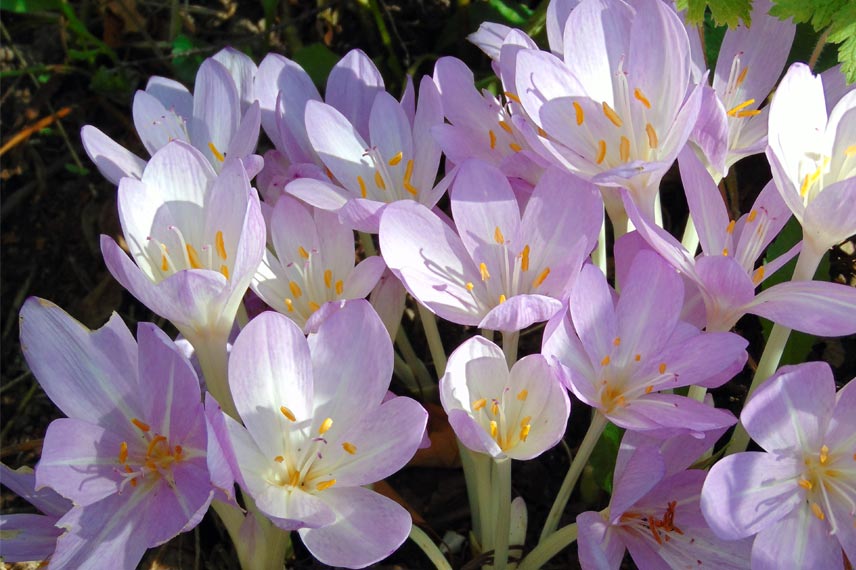
Colchicum autumnale
Lily of the Valley
Small posies are made in May, but did you know that lily-of-the-valley is a toxic plant? All parts contain saponins, irritating to the digestive tract, and cardiotoxic glycosides, toxic to the heart. This pretty plant is therefore dangerous to both animals and children if ingested, even vase water. Depending on amount ingested and age of person, consequences range from digestive upset to cardiac arrest. However, if no one is likely to ingest it, you can certainly plant it at home!
This woodland plant thrives in shade or partial shade in fresh, humus-rich, loose, light soil. This perennial groundcover produces small bell-shaped flowers with a subtle scent. It forms small tufts not exceeding 20 cm high. Convallaria bears erect, ovate leaves arising around base of stem. Their bright green contrasts with the white of the small bells. The true woodland lily-of-the-valley, Convallaria majalis has white flowering, but there is a variety with pink flowers: Convallaria majalis ‘Rosea’. Whichever variety chosen, lily-of-the-valley is hardy, tolerates down to -15°C.
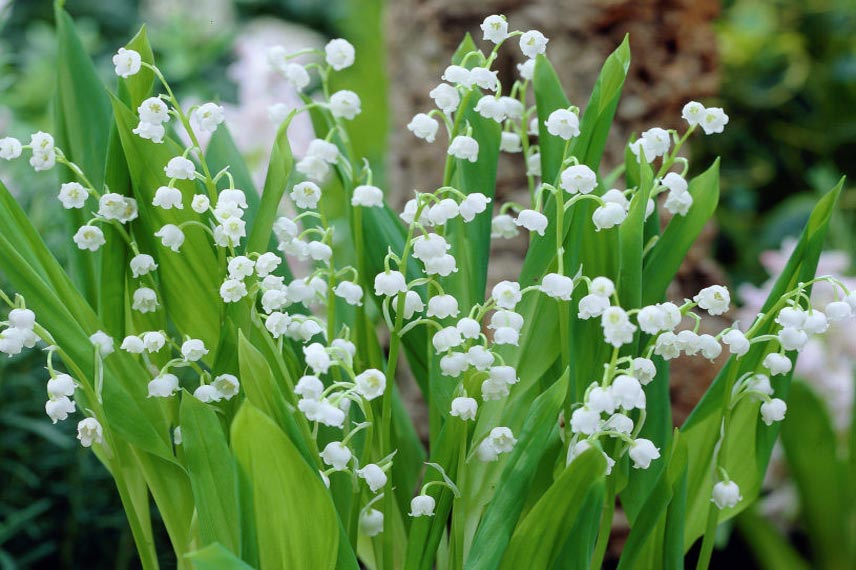
White lily-of-the-valley (Convallaria majalis)
Oleander
Once again, all parts of the plant are toxic. They contain cardiotonic glycosides causing vomiting, abdominal pain and headaches. Cardiac rhythm disturbances can also occur. Serious poisonings are rare, since children never ingest large quantities, the plant having a very bitter taste.
Despite this toxicity, which should be known, oleander is the star of regions with a mild climate. In summer, this floriferous bush is adorned with a multitude of small, melliferous pink, yellow, orange, red or white flowers. Typical of Mediterranean gardens, it thrives in well-drained (even dry), rich soil and full sun. Nerium oleander is tender but some varieties are hardier than others, such as Nerium oleander ‘Rouge Double’ (-8°C, -10°C). Cooler regions can grow it in a pot. From -5°C, it is advisable to bring it indoors or protect it from cold with a good layer of mulch and horticultural fleece. You can plant oleander at the back of a border, in a mixed hedge or as a specimen. Well resistant to sea spray, it often forms coastal hedges.

Oleander (Nerium oleander)
Cytisus
Laburnum contains cytisine, a toxin similar to nicotine, and quinolizidine alkaloids. Ingestion of flowers, leaves or seeds can cause vomiting, hypersalivation, abdominal pain, sweating and cardiac arrhythmias. Fatalities are extremely rare. Vomiting occurs very quickly, which prevents ingestion of a dangerous dose, even in children.
Nicknamed yellow wisteria, this small tree produces a very melliferous display quite similar to that of the famous climbing plant. Generous yellow clusters contain numerous papilionaceous flowers, measuring between 10 cm and 50 cm long. There are three species: Laburnum anagyroides, Laburnum alpinum and Laburnum alschnigeri. Flowering occurs between May and July, followed by fruiting as brown pods. Its trifoliate foliage grows on brown wood, which earned it the common name false ebony. Native to Europe’s mountainous regions, Laburnum adapts equally well to drought, cold and wind. It thrives in sun or partial shade. You can plant it as a specimen, in an informal hedge or train it against a support. On a pergola, it creates a path lit by a cascade of countless yellow flowers from late spring.
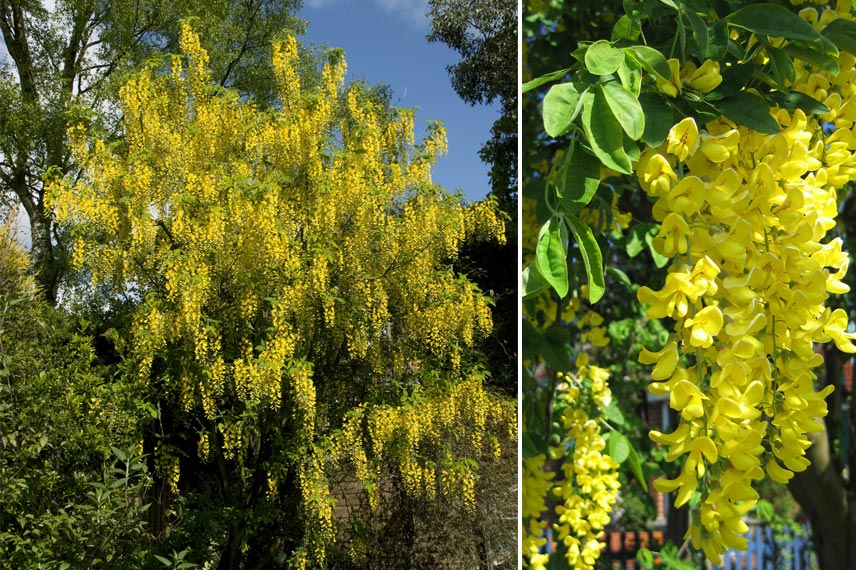
Laburnum (Laburnum cytisus)
Honeysuckle
Whole plant is toxic, but especially the fruits, small red berries that can attract young children. In children under 3 years, poisoning is considered serious after ingestion of 2–3 berries. In adults, the figure rises to 30 berries. Indeed, this causes vomiting, diarrhoea, abdominal pain, sweating, dizziness, fever, convulsions or tachycardia. Symptoms vary in severity depending on amount ingested and the person’s age.
Yet this climbing bush is popular with gardeners for its hardiness and ease of cultivation. Indeed, the honeysuckle tolerates all soil types, ideally not very calcareous. Plant in sun or partial shade. Among its 180 species, you will certainly find one suited to your garden or balcony! Its voluble lianas twine around pergolas, trellises, wire fences and arbours. Its two-coloured flowers range from white and pink to red and orange. They appear between May and October, depending on species. Highly fragrant, the flowers adorn deciduous, semi-evergreen or evergreen foliage depending on climate and variety chosen.
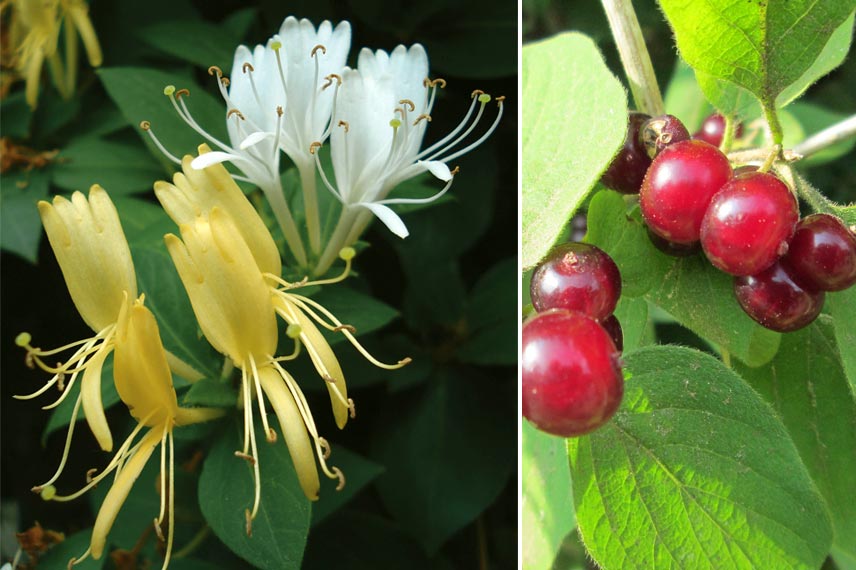
Flowers of Lonicera japonica Halliana and fruits of Lonicera xylosteum
Prevention is better than cure!
Toxic plants can be very dangerous when young children or animals that tend to nibble on plants are present. However, they do not pose a real threat to adults who are properly informed and aware of the risks posed by each plant. In general, as with mushrooms, avoid consuming plants you do not know. While our vegetable gardens may contain delights, that is not the case for all plants. Their ornamental qualities are of real interest in the garden, benefiting those who are aware of their toxic character.
- Subscribe!
- Contents
































Comments